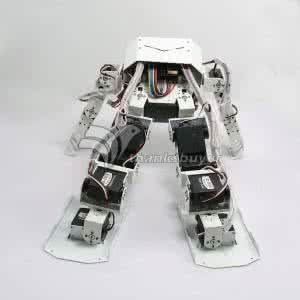Legged locomotion in humans is governed by natural dynamics of the human body and neural control. One mechanism that is assumed to contribute to the high efficiency of human walking is the impulsive ankle push-off, which potentially powers the swing leg catapult. However, the mechanics of the human lower leg with its complex muscle-tendon units spanning over single and multiple joints is not yet understood. Legged robots allow testing the interaction between complex leg mechanics, control, and environment in real-world walking gait. We developed a 0.49m tall, 2.2kg anthropomorphic bipedal robot with Soleus and Gastrocnemius muscle-tendon units represented by linear springs, acting as mono- and biarticular elastic structures around the robot's ankle and knee joints. We tested the influence of three Soleus and Gastrocnemius spring-tendon configurations on the ankle power curves, the coordination of the ankle and knee joint movements, the total cost of transport, and walking speed. We controlled the robot with a feed-forward central pattern generator, leading to walking speeds between 0.35m/s and 0.57m/s at 1.0Hz locomotion frequency, at 0.35m leg length. We found differences between all three configurations; the Soleus spring-tendon modulates the robot's speed and energy efficiency likely by ankle power amplification, while the Gastrocnemius spring-tendon changes the movement coordination between ankle and knee joints during push-off.
翻译:人体的腿部畸形由人体的自然动态和神经控制调节。一种机制假定有助于提高人类行走效率。一种机制假定有助于提高人类行走效率。一种机制是脉冲脚踝推推,这有可能使秋腿跳出。然而,人类下腿的机械结构及其复杂的肌肉特高度单位分布在单关节和多个关节上,尚不为人所知。牵动机器人可以测试复杂的腿力力、控制和真实世界行走运动的环境之间的相互作用。我们开发了0.49米高的2.2公斤人体畸形双性双膝机器人,由索尔乌斯和加斯特诺尼尤斯的脚踝脚踝脚踝加速器所代表,作为单项和双项弹性结构,在机器人脚踝和膝膝关关关关关关关关关关关紧。我们测试了三个Sollius和Gastroonnenicial-tendodform 的脚踝节能曲线、脚踝和脚下运动总成本和行走速。我们用一个反馈的中央式中央模式发电机对机器人进行了控制,以双向向方向运动速度动作运动速度动作动作动作运动,在0.5和速度之间可能以0.5摩的频率变速度变速度调之间,在0.5和0.5。





